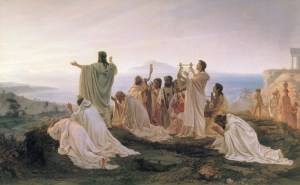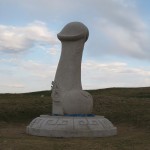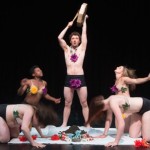In Part 1, I traced the development of Unitarianism since the early 19th century to the present and argued that UUism has, since its inception, been characterized by what William Channing called a “too partial culture of the mind.” In Part 2, I argued that the “one needful thing” for contemporary humanistic UUism is a transformative experience of self-transcendence. I also hinted that this might be needed in humanistic/naturalistic Paganism.
In response to Part 2, D.T. Strain wrote about his own naturalistic transformative experiences. He then went on to outline several serious roadblocks that stand between the humanist/naturalist and these kinds of experiences. I urge you to read D.T.’s full response to Part 2. He states that the tendency of humanists/naturalists toward objective descriptions interferes with our subjective experience. “We cannot achieve greater subjective intuitive experience through greater objective intellectual knowledge alone. We are still holding on to the edge of the pool, scared to float.” No matter how much we learn about a religious practice, says D.T., we will never be able to evaluate their worth until we experience them from a different mindset. “This is because they are inherently subjective experiences. The way you investigate them is by engaging in them without reservation – to be willing to make a leap.” He writes:
“Many of we rationalists, humanists, etc. sit against the wall at the dance, talking with one another about the dancers out on the floor – analyzing their movements, critiquing their techniques. Then we speculate about the biological underpinnings of their enjoyment of the dance, imagining that this discussion and knowledge somehow gets us closer to being good dancers or to sharing in that enjoyment. The lights come on, the party is over, and we go home completely failing to have ever danced or even understood what it was like.”
This is precisely what I was talking about in my post “Why Unitarians Can’t Dance.” And it may apply to humanistic/naturalistic Pagans with equal force. I know it applies to me at least — a member of both communities. I agree with D.T. that, if we are to “truly heal the schism and reunite the natural and the sacred”, then our engagement must be practical, personal, and emotional, at least as much as it is analytical and critical. Here are a few ideas I have about how we might accomplish that.
1. Make ritual more poetic.
There are many ways that we can get off the wall and “dance”, so to speak. One way is by engaging in ritual that is more poetic. Defining “poetry” could be challenging, but I find the wikipedia definition functional for present purposes: poetry is an art “which uses the aesthetic qualities of language to evoke meanings in addition to, or in place of, the prosaic ostensible meaning.” I use poetic language to speak indirectly about those things that seem to slip from our grasp when we talk about them directly. Poetry uses symbolic language to do this, and ritual is symbolic action.
UUism has very little ritual, due to a distrust of liturgy that dates back to the 19th century. But even Neopaganism, which is full of ritual, could improve in this area, I think. I find that a great deal of Neopagan ritual, is discursive, sometimes verbose, and at its worst didactic. The worst examples, I think, are “rituals” where the officiant gives a sermon or homily on the meaning of the Sabbat. In these case, “ritual” takes the form of talking about an experience, rather than having an experience. This is how most CUUPS rituals are conducted, and I suspect it is due to the influence of UU humanism.
Part of the excessive wordiness of some ritual comes from a distrust of symbolism that is common to humanists. Most people probably equate symbols with metaphors, but I have argued previously that they are not the same. The meaning of a metaphor is known. But a symbol carries with it a surplus of meaning which cannot be conveyed through explanation. A metaphor is a known quantity, but a symbol is practically inexhaustible. Ritual uses symbolic words and actions to evoke this surplus of meaning.
I have heard the complaint by some atheists that we should just say what we mean and then symbolic language would be unnecessary. But I believe this betrays a fundamental misunderstanding of the nature of symbol. Symbolic language is not representational language; it is evocative language. If we can embrace this understanding of symbol, I think our rituals will become less wordy, more evocative, and potentially more likely to be transformative. And we need not write our own poetry in order to do this. We have Schiller, Holderlin, Byron, Wordsworth, Swinburne. We have Mary Oliver, Rilke, Adrienne Rich, Wendell Berry, David Whyte. And so many others whose words resonate with many naturalistic Pagans and can be borrowed for our rituals.
2. Seek group rituals.
Another way I think we can try to “let go of the side of the pool”, as D.T. suggests, is to find others like-minded Pagans and have group rituals. Being an introvert, this would be very challenging for me. I feel anxiety even suggesting it. But I am slowly coming to the conclusion that there is an experience which can be had in groups which is very difficult to reproduce by one’s self. Our small numbers make solitary practice the norm for most humanistic/naturalistic Pagans. And the result, I think, is that our experience of ritual is different from that of many Pagans who worship more in groups. It’s no accident, I think, as Gus Dizerega explains in his recent post, “Encountering Pagan Deities”, that group ritual has been the most consistent factor in his most powerful experiences of deity.
As noted in my previous post, Alan Watts defines “worship” as the realization of unity with God/Reality “through corporate self-forgetfulness”. Obviously there is such a thing as private, individual worship. But, in some ways group worship carries with it greater possibilities for self-transcendence. There is a reason that the Dionysian bacchantes were always found in a group. Most of a humanistic/naturalistic persuasion probably have a higher than average level of distrust of groups. But it may be our fear of group-think and mob mentality that stands in the way of those experiences which have little to do with rationality.
3. Engage in devotional practice.
In the paragraph above, I mentioned “worship”. “Worship” is itself a problematic term in a naturalistic context. It often refers to an act of religious devotion, and devotional practice that is not usually found (or recognized) in humanistic or naturalistic contexts. Some might even suggest that a humanistic or naturalistic practice is actually defined by its non-devotional nature.
The word “devotion” derives from the same root as the word “vow”, which implies a kind of giving of oneself. Devotion also implies a kind of love for an “other”. And love, I think, can be an effective means of ego-transcendence. But what are we to love? Theodore Parker wrote of the Unitarians of his day, “ceasing to fear ‘the great and dreadful God’, they had not quite learned to love the … Universe.” The same might be said of naturalistic/humanistic Pagans today. The question for us is whether can we develop a devotional practice in relation to an impersonal earth, nature, or universe?
While devotional practice usually corresponds with notions of a personal deity, personification may not be necessary. Evelyn Underhill defines worship in terms that include the impersonal. Worship, she writes, is
“the absolute acknowledgment of all that lies beyond us—the glory that fills heaven and earth. It is the response that conscious beings make to their Creator, to the Eternal Reality from which they came forth; to God, however they may think of Him or recognize Him, and whether He be realized through religion, through nature, through history, through science, art, or human life and character.”
One need only remove the references to “God” and “Creator” for this statement to apply in a naturalistic context: worship is the acknowledgement of what lies beyond us, a response of conscious beings to reality, however they think of it and however it is realized. Thus, worship is, at its essence, a response to an experience of otherness which transcends the self to one degree or another. It is a response to the feeling of awe, something which is probably familiar to most naturalistic Pagans.
But devotional worship is a specific kind of response. “Worship” is related to the word “veneration”, but it is also related to the word “adoration”. Veneration is a recognition of greatness or immensity in the object of veneration, while adoration is more akin to what we call “love”. Devotional worship includes both of these elements. While the forms of devotional worship may be alien to many naturalistic Pagans, I think many of us may already be practicing devotionalism in spirit.

The question then is whether we can translate devotional practices into a naturalistic context. In practical terms, devotionalism often takes the form of some form of offering: of praise, of things (like foodstuffs), of vows, and ultimately the offering of one’s self. In a naturalistic context, these are not “sacrifices” or even “offerings” in the sense in which many polytheists use the term. These are not gifts given in the hopes of receiving divine favor or receiving something in return. They are expressions of devotion, of love. Underhill writes, “Perhaps the most significant development in human religion has been the movement of the idea of sacrifice from propitiation to love.”
I think anything we do, in fact everything we do, could be an offering of love . . . to life or to the world. Evelyn Underhill wrote that worship can include all forms of human activity. Worship, she says,
“is an instinct that finds expression not only in our devotional, but also in our æsthetic life. The inspiration of the painter, the musician and the poet, and often that of the scientist and explorer too, contains a genuine element of worship. All that is best of these great human activities is not done for our own sakes; it points right away from us, to something we humbly seek and half-ignorantly adore. It is offered at the shrine of a beauty or a wisdom that lies beyond the world.”
And eventually, we will offer our very lives back to nature. But we can also express this ritually, in the form of other more traditional offerings, like praise or libations.
I admit, I’m not sure what all of this looks like. But I can imagine humanistic and naturalistic Pagans engaging in poetic ritual, together, as an expression of our love for life and the universe.















